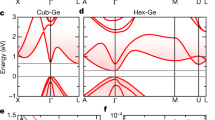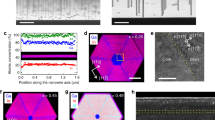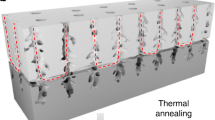Abstract
Crystalline silicon is an indirect-bandgap semiconductor, making it an inefficient emitter of light. The successful integration of silicon-based electronics with optical components will therefore require optically active (for example, direct-bandgap) materials that can be grown on silicon with high-quality interfaces. For well ordered materials, this effectively translates into the requirement that such materials lattice-match silicon: lattice mismatch generally causes cracks and poor interface properties once the mismatched overlayer exceeds a very thin critical thickness. But no direct-bandgap semiconductor has yet been produced that can lattice-match silicon, and previously suggested structures1 pose formidable challenges for synthesis. Much recent work has therefore focused on introducing compliant transition layers between the mismatched components2,3,4. Here we propose a more direct solution to integrating silicon electronics with optical components. We have computationally designed two hypothetical direct-bandgap semiconductor alloys, the synthesis of which should be possible through the deposition of specific group-IV precursor molecules5,6 and which lattice-match silicon to 0.5–1% along lattice planes with low Miller indices. The calculated bandgaps (and hence the frequency of emitted light) lie in the window of minimal absorption in current optical fibres.
This is a preview of subscription content, access via your institution
Access options
Subscribe to this journal
Receive 51 print issues and online access
$199.00 per year
only $3.90 per issue
Buy this article
- Purchase on Springer Link
- Instant access to full article PDF
Prices may be subject to local taxes which are calculated during checkout


Similar content being viewed by others
References
Wang, T., Moll, N., Cho, K. & Joannopoulos, J. D. Deliberately designed materials for optoelectronics applications. Phys. Rev. Lett. 82, 3304–3306 (1999).
Ejeckam, F. E., Lo, Y. H., Subramanian, S., Hou, H. Q. & Hammons, B. E. Lattice engineered compliant substrate for defect-free heteroepitaxial growth. Appl. Phys. Lett. 70, 1685–1687 (1997).
Lo, Y. H. New approach to grow pseudomorphic structures over the critical thickness. Appl. Phys. Lett. 59, 2311–2313 (1991).
Powell, A. R., Iyer, S. S. & LeGoues, F. K. New approach to the growth of low dislocation relaxed SiGe material. Appl. Phys. Lett. 64, 1856–1858 (1994).
Kouvetakis, J., Nesting, D. & Smith, D. J. Synthesis and atomic and electronic structure of new Si-Ge-C alloys and compounds. Chem. Mater. 10, 2935–1949 (1998).
Kouvetakis, J., Chandrasekhar, D. & Smith, D. J. Growth and characterization of thin Si80C20 films based upon Si4C building blocks. Appl. Phys. Lett. 72, 930–932 (1998).
Jenkins, D. W. & Dow, J. D. Electronic properties of metastable GexSn1-x alloys. Phys. Rev. B 36, 7994–8000 (1987).
Mäder, K. A., Baldereschi, A. & von Känel, H. Band structure and instability of Ge1-xSnx alloys. Solid State Commun. 69, 1123–1126 (1989).
He, G. & Atwater, H. A. Interband transitions in SnxGe1-x alloys. Phys. Rev. lett. 79, 1937–1940 (1997).
Min, K. S. & Atwater, H. A. Ultrathin pseudomorphic Sn/Si and SnxSi1-x/Si heterostructures. Appl. Phys. Lett. 72, 1884–1886 (1998).
Klinkhammer, K. W., Kühner, S., Regelmann, B. & Weidlein, J. Die Kristall- und Molekulstruktur von Tetrakis(trimethylstannyl)methan. Organomet. Chem. 496, 241–243 (1995).
Schmidbaur, H. & Zech, J. An improved synthetic pathway to tetrasilyl methane and the synthesis of disilylpropane. Eur. J. Solid State Inorg. Chem. 29, 5–21 (1992).
Kouvetakis, J. et al. Novel methods for CVD of Ge4C and (Ge4C)xSiy diamond-like semiconductor heterostructures: Synthetic pathways and structures of trigermyl-(GeH3)3CH and tetragermyl-(GeH3)4C methanes. J. Am. Chem. Soc. 120, 6738–6744 (1998).
Ihm, J., Zunger, A. & Cohen, M. L. Momentum-space formalism for the total energy of solids. J. Phys. C 12, 4409–4423 (1979).
Hybertsen, M. S. & Louie, S. G. Electron correlation in semiconductors and insulators: Band gaps and quasiparticle energies. Phys. Rev. B 34, 5390–5413 (1986).
Rücher, H., Metthfessel, M., Bugiel, E. & Osten, H. J. Strain-stabilized highly concentrated pseudomorphic Si1-xCx layers in Si. Phys. Rev. Lett. 72, 3578–3581 (1994).
Herman, M. A. & Sitter, H. Molecular Beam Epitaxy: Fundamentals and Current Status (Springer, Berlin/Heidelberg, 1989).
Corkill, J. L. & Cohen, M. L. Band gaps in some group-IV materials: A theoretical analysis. Phys. Rev. B 47, 10304–10309 (1993).
Cohen, M. L. & Chelikowsky, J. R. Electronic Structure and Optical Properties of Semiconductors (Springer, Berlin/Heidelberg, 1988).
Acknowledgements
V.H.C. thanks T. Mallouk and J. Kouvetakis for useful discussions and J. Kouvetakis for information on the stability of Sn-D3 moiety. V.H.C. acknowledges support from the Packard Foundation and from the National Science Foundation, Division of Materials Research. V.H.C. also acknowledges the National Partnership for Advanced Computational Infrastructure and the Pittsburgh Supercomputing Center for computational support. M.L.C. and S.G.L. acknowledge support from the National Science Foundation, Division of Materials Research and from the Office of Energy Research, Office of Basic Energy Sciences, Materials Sciences Division of the US Department of Energy.
Author information
Authors and Affiliations
Corresponding author
Rights and permissions
About this article
Cite this article
Zhang, P., Crespi, V., Chang, E. et al. Computational design of direct-bandgap semiconductors that lattice-match silicon. Nature 409, 69–71 (2001). https://doi.org/10.1038/35051054
Received:
Accepted:
Issue Date:
DOI: https://doi.org/10.1038/35051054
This article is cited by
-
Direct bandgap emission from strain-doped germanium
Nature Communications (2024)
-
Optical and electronic properties of pure and fully hydrogenated SiC and GeC nanosheets: first-principles study
Optical and Quantum Electronics (2018)
-
Non-equilibrium induction of tin in germanium: towards direct bandgap Ge1−xSnx nanowires
Nature Communications (2016)
-
Dipole-allowed direct band gap silicon superlattices
Scientific Reports (2015)
-
Computational materials science: The emergence of predictive capabilities of material behaviour
Sadhana (2003)
Comments
By submitting a comment you agree to abide by our Terms and Community Guidelines. If you find something abusive or that does not comply with our terms or guidelines please flag it as inappropriate.



